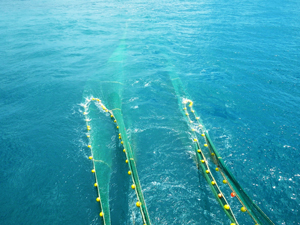Suriname tests a flexible Turtle Excluder Device (TED) for finfish trawls
Paramaribo, 1 November 2017
As one of the only countries in the region, Suriname has a trawling fleet for demersal finfish. The fishery is known to occasionally capture sea turtles and other potentially vulnerable species including rays, sharks and groupers. The REBYC-II LAC project in Suriname aims to reduce this unsustainable bycatch by implementing a suitable Turtle Excluder Device (TED) for this fishery.
 Twin-rig trawling allowed for direct catch comparison between the trawls with and without a cable grid. |
Traditional TEDs, developed for shrimp trawls, consist of a rigid sorting grid, installed near the codend of the trawl. Due to the differences in target species, scale and operation, it is a major challenge to make TED technology work in finfish trawls. The main obstacle is the fact that finfish trawls are mostly retrieved using a net reel. This prohibits the use of rigid TEDs, as they would be bended and crushed when the net is winded on the reel. To overcome this problem, the Harvesting Systems Unit of NOAA’s National Marine Fisheries Service (USA), has developed a flexible TED for finfish trawls. Instead of rigid aluminum bars, the grid is made of stainless steel cable, and is therefore also referred to as a cable grid.
On request from the Suriname Fisheries Department, NOAA developed two prototype cable grids for the Surinamese finfish fishery. To allow larger fishes to be retained by the trawl, the prototype grids had bar spacings of respectively 5 and 7 inches, compared to the regular 4-inch bar spacing on a shrimp TED. With support from Nicholas Hopkins, NOAA fishing gear specialist, these prototypes were tested during a seven-day sea trip in October 2017. The first results of these sea-trials are promising. The grids excluded large quantities of unwanted bycatch, with reductions in ray bycatch as high as 95%. Although the capture of target fish was reduced, overall the grids retained the target catch quite well. Underwater recordings of the grids provided very valuable insights on their functioning.
 Trawl-camera image showing the cable grid while fishing. |
The results were presented to stakeholders during a REBYC National Working Group meeting on 30 October 2017. During this meeting, several ideas were put forward and discussed to make further adaptations to the gear. The main challenge will be improving the grids to maximize target catch retention. To this end, further sea trials and evaluations will be planned, with the continued support of NOAA.
